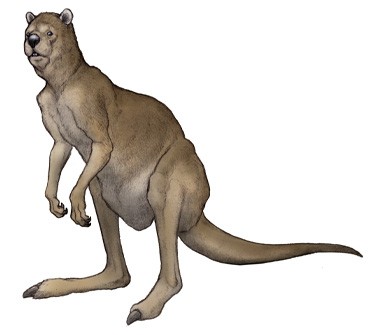Giant Kangaroo Ancestors Walked Like Humans
| Ana Verayo | | Oct 16, 2014 04:12 AM EDT |
(Photo : Geocities Japan) The Procoptodon goliah walked upright, stood six feet tall and weighed more than 500 pounds.
The ancestors of today's kangaroos walked and didn't hop across the ground, says new research from Brown University in Rhode Island.
Researchers analyzed bone and body structures of extinct giant kangaroo ancestors and discovered they apparently didn't have the ability to hop unlike modern day kangaroo.
Like Us on Facebook
These ancient kangaroos called "sthenurines" were indigenous to Australia around 13 million years ago. The animals died out 30,000 years before the Common Era, which wasn't long before the first humans emerged on the continent.
The largest species from the sthenurine family are the Procoptodon goliahs that stand over six feet tall and measured 10 feet long from nose to tail. They weighed a massive 530 pounds and had faces resembling modern day rabbits.
They walked upright like humans as opposed to modern kangaroos that cannot walk this way.
According to Christine Janis, paleontologist from Brown University, today's kangaroos hop fast. But at a slower pace, kangaroos revert to a pentapedal walk where they use their four legs and their tail.
Researchers investigated 140 kangaroo skeletons. They also examined kangaroo cousins like wallabies and found body structure evidence that kangaroo ancestors indeed walked instead of hopped.
Teeth samples also demonstrated these ancestors ate leaves from the trees as opposed to grass and bushes, proving these extinct animals stood upright.
Researchers also believe smaller sthenurines preferred walking most of the time despite having the capability to hop at fast speeds. Larger sthenurines were more likely to walk compared to the smaller species.
The sheer gargantuan size of the Procoptodon suggested they had a difficult time hopping because of their limited tendon strength. The Procoptodon species are also described as having a short face instead of their modern counterparts that have long faces.
This study of kangaroo ancestors was published in the journal, PLOS One.
TagsGiant Kangaroo Ancestors Walked Like Humans Not Hopped, Australia, kangaroos, kangaroo ancestors, giant huge ancient ancestors kangaroos walked not hopped too heavy, procoptodon
©2015 Chinatopix All rights reserved. Do not reproduce without permission
EDITOR'S PICKS
-

Did the Trump administration just announce plans for a trade war with ‘hostile’ China and Russia?
-

US Senate passes Taiwan travel bill slammed by China
-

As Yan Sihong’s family grieves, here are other Chinese students who went missing abroad. Some have never been found
-

Beijing blasts Western critics who ‘smear China’ with the term sharp power
-

China Envoy Seeks to Defuse Tensions With U.S. as a Trade War Brews
-

Singapore's Deputy PM Provides Bitcoin Vote of Confidence Amid China's Blanket Bans
-

China warns investors over risks in overseas virtual currency trading
-

Chinese government most trustworthy: survey
-

Kashima Antlers On Course For Back-To-Back Titles
MOST POPULAR
LATEST NEWS
Zhou Yongkang: China's Former Security Chief Sentenced to Life in Prison

China's former Chief of the Ministry of Public Security, Zhou Yongkang, has been given a life sentence after he was found guilty of abusing his office, bribery and deliberately ... Full Article
TRENDING STORY

China Pork Prices Expected to Stabilize As The Supplies Recover

Elephone P9000 Smartphone is now on Sale on Amazon India

There's a Big Chance Cliffhangers Won't Still Be Resolved When Grey's Anatomy Season 13 Returns

Supreme Court Ruled on Samsung vs Apple Dispute for Patent Infringement

Microsoft Surface Pro 5 Rumors and Release Date: What is the Latest?










